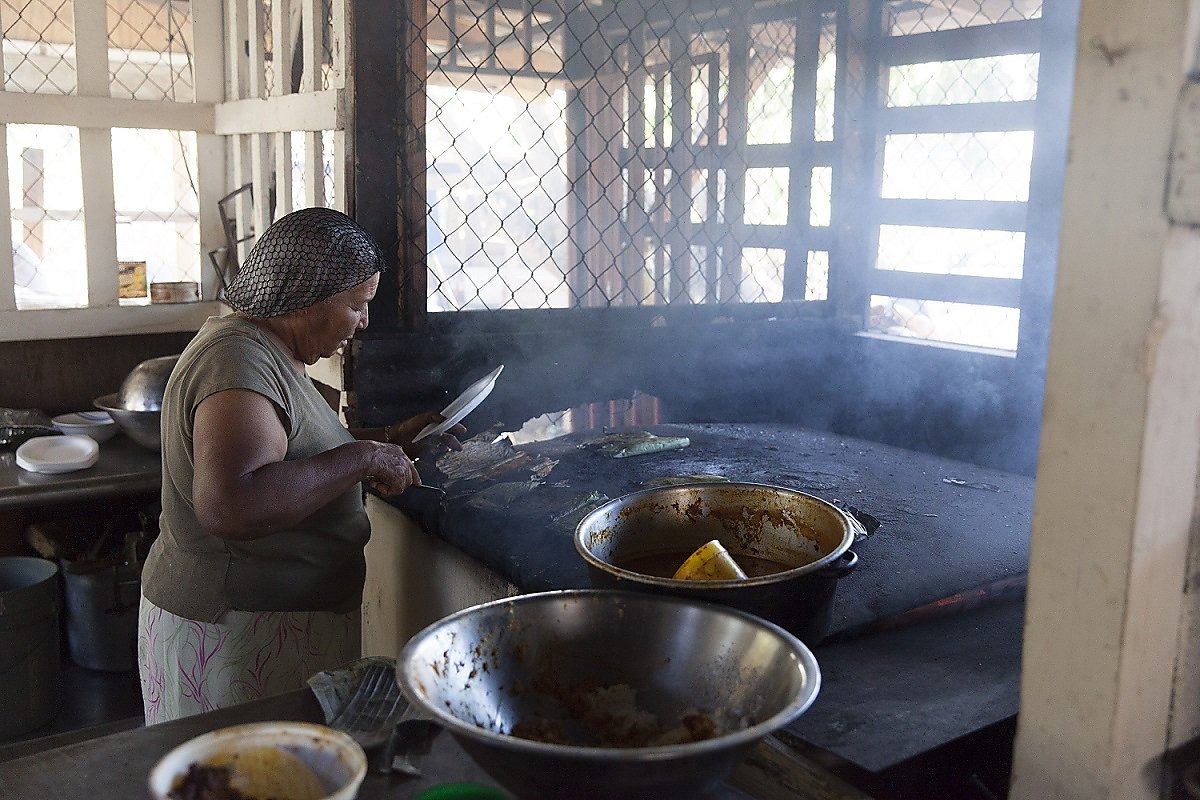
15 Feb A pilgrimage to the keeper of Puerto Rico’s past, before she disappears

I knew I wanted to be a food writer. That’s why I went to culinary school. I figured that if I was going to do any justice to the pen and paper, I better know the ins and outs of the industry. But I couldn’t see a clear path on what to do with writing or where it would take me. My visit with Lula set the whole thing in motion. Suddenly, it became very clear.
El Buren de Lula is a restaurant owned by an 82-year-old mystic named Maria Dolores de Jesus, also known as Lula. She has become a beacon of history and culture in the Puerto Rican town of Loiza, where descendants of slaves built their communities. It is considered the cradle of African traditions in Puerto Rico.
Beginning at 7 o’clock in the morning, Lula can be seen pacing throughout her outdoor kitchen preparing food for sale. Like most Puerto Ricans, she has several calderos, bare aluminum pots that evenly conduct heat, all thin enough to create pegao — the prized crispy rice at the bottom.
But the real star here is the hot beast that dominates an entire side of the room: The buren.
Once upon a time, the Taino, the island’s indigenous people, cooked either on open fires using woven surfaces made out of green wood (barbacoa) or the buren, a huge, flat surface made out of clay harvested from rivers and heated with stones.
Lula mostly cooks pre-contact recipes, a lot of which feature coconut and cassava, on the buren. It has evolved into a metal plancha, the closest modern recreation possible of the Tainos’ clay cooking surface.
When you’re from a colony, it’s nearly impossible to track down the history of your food. Combine that with a long history of passing recipes down almost exclusively in an oratory form, and you’ve got a disaster of no-documentation. Once it’s gone … it’s gone.
According to residents of Loiza, Lula is the last remaining institution who regularly uses the buren; she is a living, breathing piece of history. I received a notice the other day that she was ill. And after she passes, the craft could disappear.
If Lula is the last connection to our pre-contact gastronomic world, should we be content with photos for the inevitable future “anthropologist” who wants to teach a class on long-disappeared cooking techniques? While the younger generation loses the desire to create the food of our grandmothers — favoring the addictive spell of American fast-food chains or the Eurocentric lullaby of soigne plating techniques — perhaps it’s the task of the Disasporican to preserve the traditions of our ancestors.

Photo: Dan Liberti
In the spring of 2015, I set out on a research trip to Puerto Rico. From the airport, our taxi shuffled through speeding cars as we flew past concrete housing developments, myriad satellite dishes reaching for the sky like vines to sunlight. This was not the Puerto Rico in the postcards. Financial turmoil was on the minds of many Puerto Ricans, both on the island and the mainland.
We almost didn’t make it out to Lula. The day before proved to us that GPS was virtually useless and that maps only work if you have a general idea of where you’re going. We convinced a driver, Antonio Rivera Santiago, to take us out to Loiza. He proved a necessary force: historian, navigator, translator and diplomat. We finally pulled up to the ramshackle eatery hidden in a maze of unmarked alleys. As we walked into the open and dim kitchen with glassless windows, smoke billowed from the large metal flat top.
There stood a stoic Lula, manning the entire buren on her own, fanning the fire, smearing a multitude of batters and discs of ingredients onto banana leaves and continuously shifting them around the buren into various temperature zones. When the heat started to die down, someone would go outside and feed coconut husks into the mouth of the pit under the buren.
Lula was amused by our inquisition. Her assistant, who is like a daughter to her, brought various local fruits over to us straight from their limbs: cashew apples with the cashew nut attached, breadfruit, avocados and mangos. Lula didn’t blink as we peeked into the various pots containing sauces, gravies, rices and braises.
Lula must have been convinced we’d be impressed with her yuca bread. She waved us in her direction, as if about to reveal a magic trick. She grabbed a simple wooden frame, placed it on the buren, dumped handfuls of cassava flour into the mold, made some impressions with a primitive wooden paddle and left it alone. She added nothing more than the flour — no liquid, no fat. After a minute, she flipped the mold and showed us the bread. It was solid, golden brown and crispy. She told us to dip a piece into a bubbling cauldron of red liquid. The bread tasted like pure yuca, but with toasted nutty notes. Dipped into the seasoned red sauce, it mirrored the act of dipping bread into an Italian gravy. Magic.
(A detour to talk about that flour: Many of us know yuca as cassava, a drought-tolerant woody tuber that has a waxy exterior and starchy interior, often interchanged with potatoes. Several days are dedicated to the process of making yuca flour. Wheelbarrows of yuca are peeled by hand, the white interior separated from its waxy brown skin and then cut into rough pieces. Then comes the washing, the mashing and the drying. The semi-dried mash is placed into an innovative tool: a pillowcase with one end tied around a baton and one end tied to a pole. Increments of the mash are placed inside the pillowcase and the pillowcase is squeezed tighter and tighter by hand, from the baton side, as the milky liquid falls into a collecting pan on the ground. This time the mash is dried thoroughly, sifted and stored for future use.)

Photo: Dan Liberti
It was here that I was confronted with the possibility of regional Puerto Rican cuisine. When I asked Lula about arroz con gandules, she replied, “We make arroz con jueyes around here.” Arroz con jueyes (crabs), with beans and pig’s feet. The blue land crabs of Puerto Rico — hearty, stout creatures, with one claw that’s larger than the other — burrow in the ground near the mangroves along the coast. People catch them in the night and keep them in coops, replacing their scavenger diet with sweet maize and young coconut.
Lula’s arroz con jueyes was a punchy dish where sofrito and crab essence were front and center. Chunks of the crab stood in a mound on one side, with rice in the center and the beans with pig’s feet on the other side. Every bite was different. Some had strands of crab interlaced with bites of tomato-y rice. Others had beans with melty, gelatinous pig’s feet bits. Some had all of the above. It was the one dish no one asked me to share. It was the most soulful.
After we gorged ourselves, I stood alone outside her restaurant and fed her chickens. The restaurant started to fill up. As the trade winds enveloped me, the voices of the patrons mingled with the soft boleros playing on the radio, and together they spilled out of the restaurant windows. I started to cry.
I was sad that I couldn’t share that moment with my grandma and mother. And so I had to write about Lula to share that moment with them.
Before Lula, I knew that I wanted to write about food. But it was the visit to her gastronomic museum that laid the foundation for the path that would become my idée fixe — to be the one who told Puerto Rico’s food story.
I may not be able to track down my ancestors, but I know they’re there. The one thing that remained unscathed was the food. Through cooking my grandmother’s food, I learned everything about her: strife, unrequited love, poverty. Every time I cook, I’m connecting with the phantoms.
Fuente: https://www.sfchronicle.com/food/article/A-pilgrimage-to-the-keeper-of-Puerto-Rico-s-13619913.php


